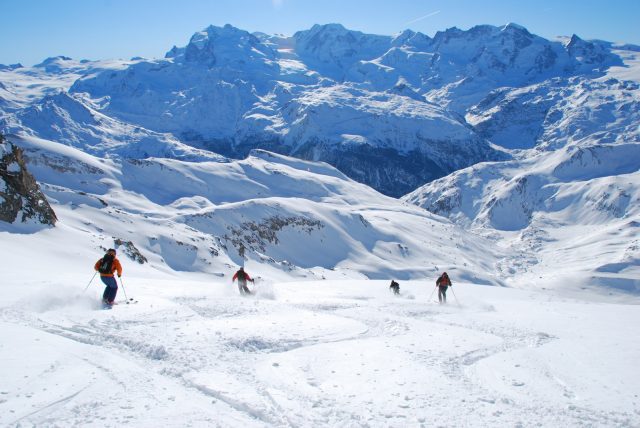How many reasons do you need to go heliskiing in Zermatt?
Canada is often regarded as the Mecca of serious powder heliskiing but Zermatt is nearer and less expensive.
Zermatt has excellent and well-organized heliskiing, plus an excellent snow record. This blog post covers:
- The history of heliskiing in Zermatt
- Heliskiing locations in Zermatt
- Heli drop points in Zermatt
- How much heliskiing in Zermatt costs
- How to book a Zermatt heliski trip
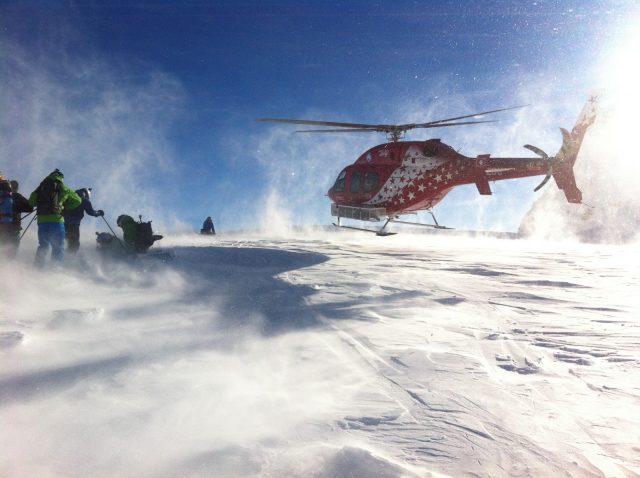
The History of Heliskiing in Zermatt
There is nothing new about the concept of flying up to ski down – before helicopters became commonplace skiers were dropped on the mountain by small fixed wing aircraft which landed on high altitude plateaus and glaciers. [You might recall an incident in 2019 when a plane landed on Mont Blanc in Chamonix.]
This, however, had its limitations and so the 1960’s saw the opening of early heli-skiing operations in North America and Europe, most famously in the Canadian Bugaboos.
With the founding of AirZermatt in 1968, principally as an air ambulance and mountain rescue service, the possibilities for more leisure-orientated use of their equipment became apparent.
With the passage of time and politics, increasing limitations were imposed on the extent of the local landing spots Zermatt, although in France and Germany heli-skiing has now been banned completely.
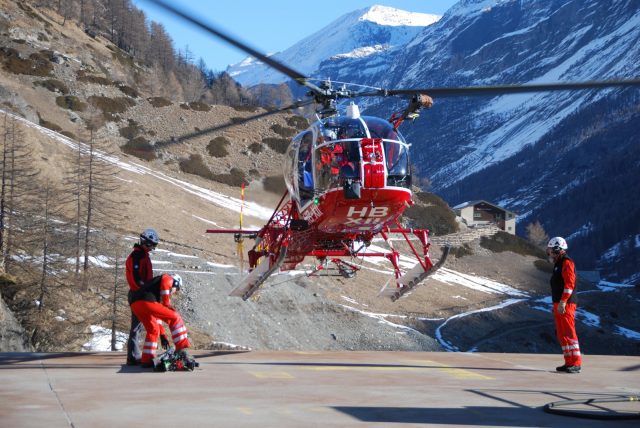
Heliskiing Locations in Zermatt
Currently, there are six official locations where Zermatt’s helicopters can land with skiers, two of which are adjacent to the pisted ski area – at Rothorn (marked 4 on the map below) and Testa Grigia (5)
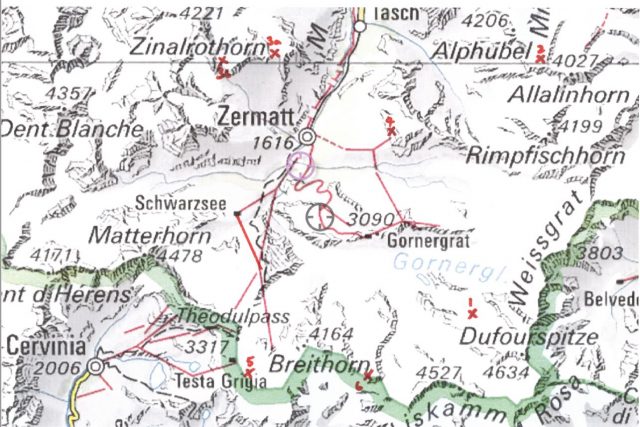
Heli-drop points in Zermatt
There are four ‘real’ heliski drop points around the Zermatt valley which, when combined with those served by Cervinia’s heliski service, just over the Italian border, provide an exciting choice of high-altitude powder skiing options from early February on.
Zermatt’s heliskiing is generally coordinated by the local mountain guides, either directly or through ‘Zermatters’. They work closely with AirZermatt, the biggest heliski operator in Switzerland and whose heliport on the edge of the village is as impressive as it is dramatic.
- Monte Rosa
This is perhaps the most popular of the heliski drop points around Zermatt and is the highest at about 4200m.
In the shadow of the Dufourspitze, and occasionally heavily windblown, this drop point opens up a choice of descents down the Monte Rosa and Grenz glaciers and onto the long Gorner glacier. This in turn brings you through a narrow gorge to Furri at 1850m and a well-earned lunch!
Later in the season, a slight detour towards the modern Monte Rosa refuge at 2883m provides for a late morning refreshment stop.
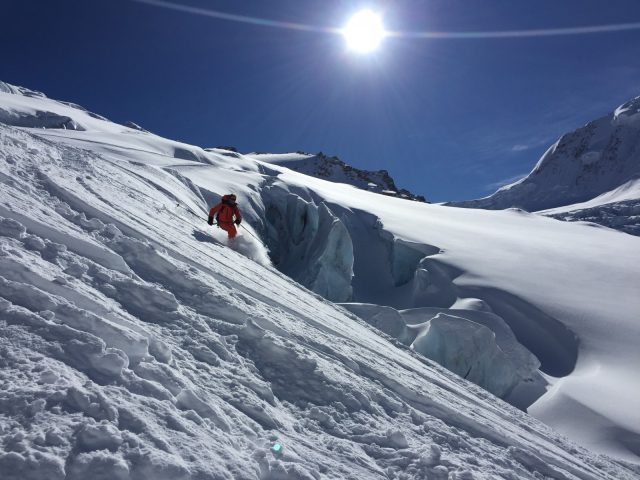
2. Alphubeljoch
The drop is at 3840m on a dome lying between Alphubeljoch and Feechopf, just to the west of the Allalinhorn in the heart of the Mischabel massif separating the Zermatt and Saas valleys.
This is a particularly ‘useful’ drop as you can ski directly back down to Täsch, just below Zermatt, and also have a good lunch at the Tascherhof Hotel.
Alternatively after a 45 minute ski from the drop point, skin up for another 45 minutes to the Allalinpass, giving access to a broad selection of possibilities on the Saas side.
A particular favourite is the long descent down to the Mattmark reservoir and then along to Saas Almagell at 1680m for a late lunch followed by a sleepy ride in a taxi back to Zermatt.
Alternatively, and depending on conditions, you can ski off-piste all the way down to Saas-Fee and then do it all over again using the lift system.
3. Aschihorn
To the north east of Zermatt and at over 3600m there are two drop spots, ‘Unter Ashihorn’ (3a) and ‘Ober Ashihorn’ (3b), which nestle dramatically under the imposing Zinalrothorn, another of Zermatt’s famous four-thousander peaks.
The more usual drop is by Unter Ashihorn from where you either ski on south-facing slopes directly towards Trift or after half an hour’s descent, skin back up to the saddle joining the Platthorn and Mettelhorn at 3400m, adding a further 800m of vertical to the day’s excursion.
Trift (2340m) is the site of the ‘Hotel du Trift’ – a picturesque high-altitude restaurant with overnight accommodation that opens only in the summer. This marks the start of a challenging descent to Zermatt via the snow-filled Triftbach gorge with its frozen waterfalls.
Because of the south-facing aspect of much of the skiing, there is often excellent ‘corn snow’ later in the season although the pleasure of this can be spoilt by the increasingly difficult passage down as the snow in the gorge melts.
The Ober Aschihorn drop, on the other hand, provides for a north- and east-facing descent overlooked by the majestic Weisshorn to Täsch, some 2200m below on the valley floor.
Conditions are generally more wintery on this side, so the powder is more dependable, especially higher-up. There’s no frozen gorge to negotiate although the final descent although the forest above Täsch can be a bit of a challenge.
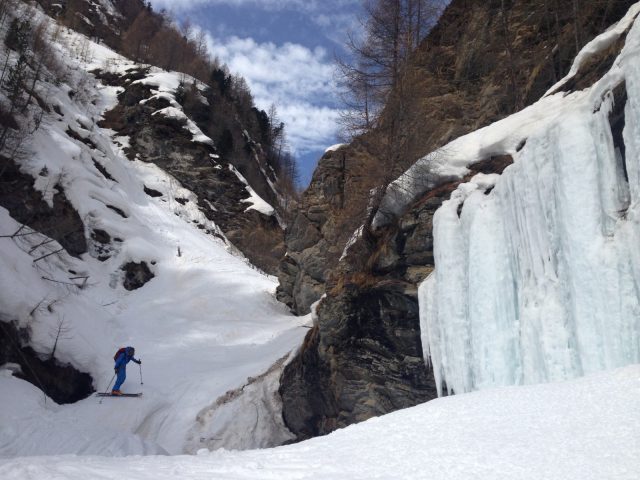
4. Schwarztor
This is probably the best value powder descent in the Zermatt area as you don’t even need a helicopter, although recently, the Italian authorities designated the Schwarztor saddle (3800m, marked 6 on the map) as an official heli-drop point.
Previously, the only access to this truly excellent and dependable powder run down the Schwarztor and Gorner glaciers was by a long traverse from Klein Matterhorn on the Italian side of the Breithorn, followed by a 30-minute skin up to the col which lies on the Italian-Swiss border.
Nowadays Italian helicopters spoil the peace of the location with parties of noisy powder-seekers brought up from Cervinia, Champoluc, Gressoney and Alagna who, after descending to Furri, use Zermatt’s lift system to return to Italy via Testa Grigia.
Part-way down, there is a variant allowing additional skiing on north-west facing slopes with a gentle skin up towards ‘Kleiner Pollux’ and the ever-changing passage through the seracs is an adventure on its own.
Other drop points include Rothorn (marked 4 on the map) and Testa Grigia (5). As we mentioned earlier, these are both adjacent to the piste, rather than ‘true’ heliski points.
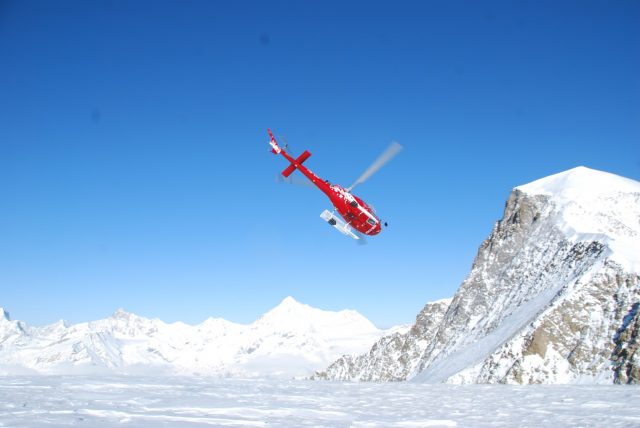
How much does heliskiing in Zermatt cost?
Prices per person for the helicopter itself work out at CHF150-200 per person depending on the drop location.
In addition, you will need to pay for your mountain guide (~CHF600) plus his place on the helicopter.
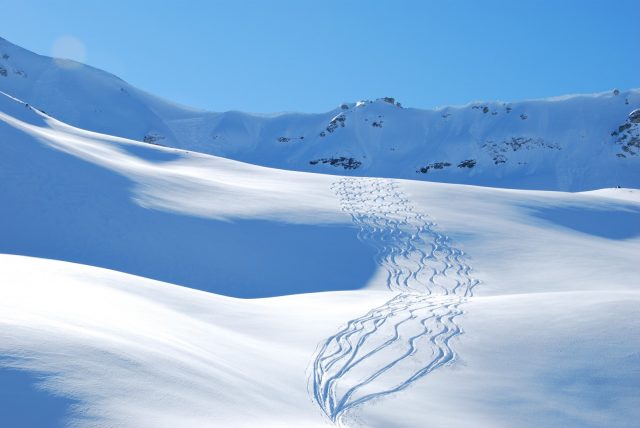
Use our concierge service to book your heliskiing
If you are staying with us at Matterhorn Chalets, as part of our concierge service, we can use our knowledge of local guides and heliski locations to book and arrange the right heliskiing trip for you and your group.
You can review our selection of apartments and serviced chalets on our website.
For advice on heliskiing and booking accommodation, please contact Ed and Suzanne from Matterhorn Chalets on +41 79 247 15 88
